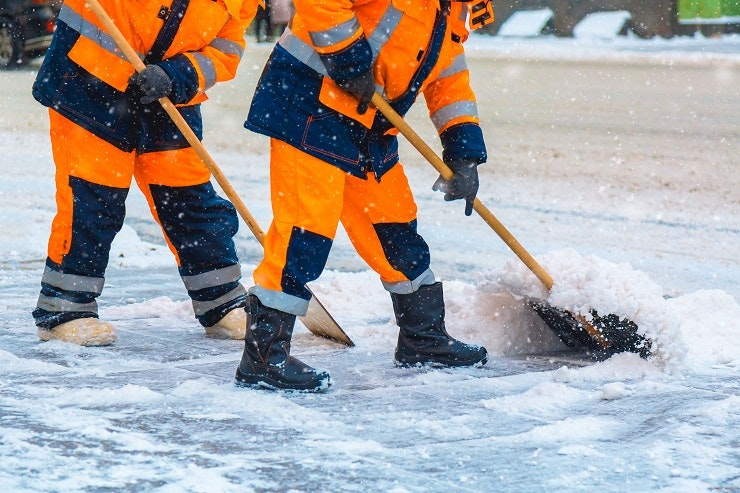
Blog
- Workplace Health & Safety
Home
Resources
Workplace Health & Safety

Michelle Ann Zoleta, Health & Safety Team Manager
(Last updated )

Michelle Ann Zoleta, Health & Safety Team Manager
(Last updated )
In Canada, severe winter conditions can bring about many challenges for those working outdoors. In industries such as construction, agriculture, transportation, oil and gas operations, and landscaping, workers are frequently exposed to the elements and inclement weather. Under those working conditions, workers can potentially develop cold stress, which happens when the body loses heat faster than it can produce it, leading to various health issues.
By understanding the signs of cold stress and how to prevent it, employers can create a safer working environment during winter months, ensure the well-being of their employees, and foster a healthier, more productive workplace.
Cold stress occurs when the body is no longer able to maintain its internal core temperature (37°C). The body then begins to redirect blood flow from the skin and extremities (arms, legs, hands, feet) to the chest and abdomen. This causes the skin and extremities to cool quickly and increases the risk of injuries such as frostbite and hypothermia.
Here are some early onset symptoms of cold stress:
Worsening symptoms:
Here are some common signs that an employee is severely affected by cold stress:
Cold stress can pose significant risks to employees who work in cold temperatures, wind, and wet conditions. Here are some of the steps and measures employers can take to prevent workers from developing cold stress:
Consider whether the work can be performed in a different environment, such as moving it indoors or postponing it to warmer months or seasons.
Modify work schedules to reduce prolonged exposure to cold. Rotate tasks or duties between employees to limit the time spent in cold environments. Also, schedule work tasks to include breaks in warm areas to allow employees to warm up.
Educate employees about the signs of cold stress, such as shivering, confusion, numbness, frostbites or frostnips, so they can recognize symptoms in themselves and their colleagues. Provide training on the importance of proper clothing and regular breaks.
Stay informed about weather forecasts, wind chill, and temperature to anticipate potential incoming risks. Plan your employees’ work and schedules around severe weather events and develop an inclement weather policy to address business closure.
This method involves modifying your equipment, worksite and work process to minimize hazards. For example, you can make changes to how employees operate machines or tools in a way that they don’t have to remove their mittens, gloves, or outerwear.
If the work is conducted outdoors and in below freezing temperatures, you could set up heated shelters or zones where employees can warm up. Access to warming shelters is vital for preventing prolonged exposure to cold conditions.
Schedule regular warm-up breaks to allow employees to recover from the cold. Encourage them to take breaks before they feel too cold, preventing the onset of cold stress.
Provide comprehensive training on recognizing and preventing cold stress. Ensure employees understand the risks, symptoms, appropriate preventive measures, and basic first aid skills. You should have at least one employee trained in dealing with cold-related emergencies per shift, so your team can respond quickly when there is an incident.
Monitor employees' health regularly, especially during extreme cold weather. Encourage them to report any signs of cold stress immediately. You can use a buddy system where workers are assigned tasks in pairs, so they can monitor each other for signs of cold stress. Also, ensure you’re familiar with the regulations in your province and are working within the safe temperature guidelines.
Hydration is essential even in cold conditions. Encourage employees to stay well-hydrated by providing access to warm beverages or soup. Additionally, promote a balanced diet to support energy levels. Avoid alcoholic drinks, coffee, or consuming food that can cause dehydration.
Introduce or recommend warm-up exercises that employees can perform before starting work in the cold. These exercises can help increase blood flow and circulation to warm the body, reducing the likelihood of getting cold stress.
Supply employees with high-quality, insulated, and waterproof clothing. This may include jackets, pants, boots, and other equipment necessary for working in cold conditions. Any PPE you provide must be suitable for the specific conditions employees will face, which could include factors like wind, humidity, and temperature.
Instruct employees on the importance of layering clothing for insulation. Multiple layers trap warmth better than a single thick layer. Here are a few layering techniques for keeping warm:
Your new workers need time to become fully acclimatized to working in cold environments. To help them ease into their work situations faster, you can provide onboarding and orientation programs to include components that address working in the cold and preventing cold stress.
Here are some key elements you can include:
Include a dedicated section in your onboarding program that educates employees on what cold stress is, its symptoms, and the importance of prevention.
Provide information about factors that contribute to cold stress, such as wind chill, humidity, and temperature, and explain how these elements impact the body. You should gradually increase the workload of new workers or those returning to work in cold environments so they have time to develop a cold tolerance.
Clearly communicate the dress code for working in cold environments. Detail the importance of layering, wearing insulated clothing, and using appropriate accessories like hats and gloves. Provide new employees with the necessary and appropriate PPEs for their tasks and working conditions.
Educate new employees about emergency procedures related to cold stress, including how to recognize signs of hypothermia or frostbite and the steps to take in case of an emergency.
Keep employees informed about changes to training or work policies related to cold stress prevention. Employers should update their training programs regularly to reinforce cold stress awareness and best practices. The programs must align with the most current provincial OHS legislation and labour laws
Our award-winning team can help you develop health and safety policies for dealing with cold stress and emergencies. We can assess your workplace for risks, take care of all your essential H&S documentation, and create contracts, employee handbooks, and more. Call 1(833) 247-3652 today to find out more.
Home
Resources
Workplace Health & Safety
